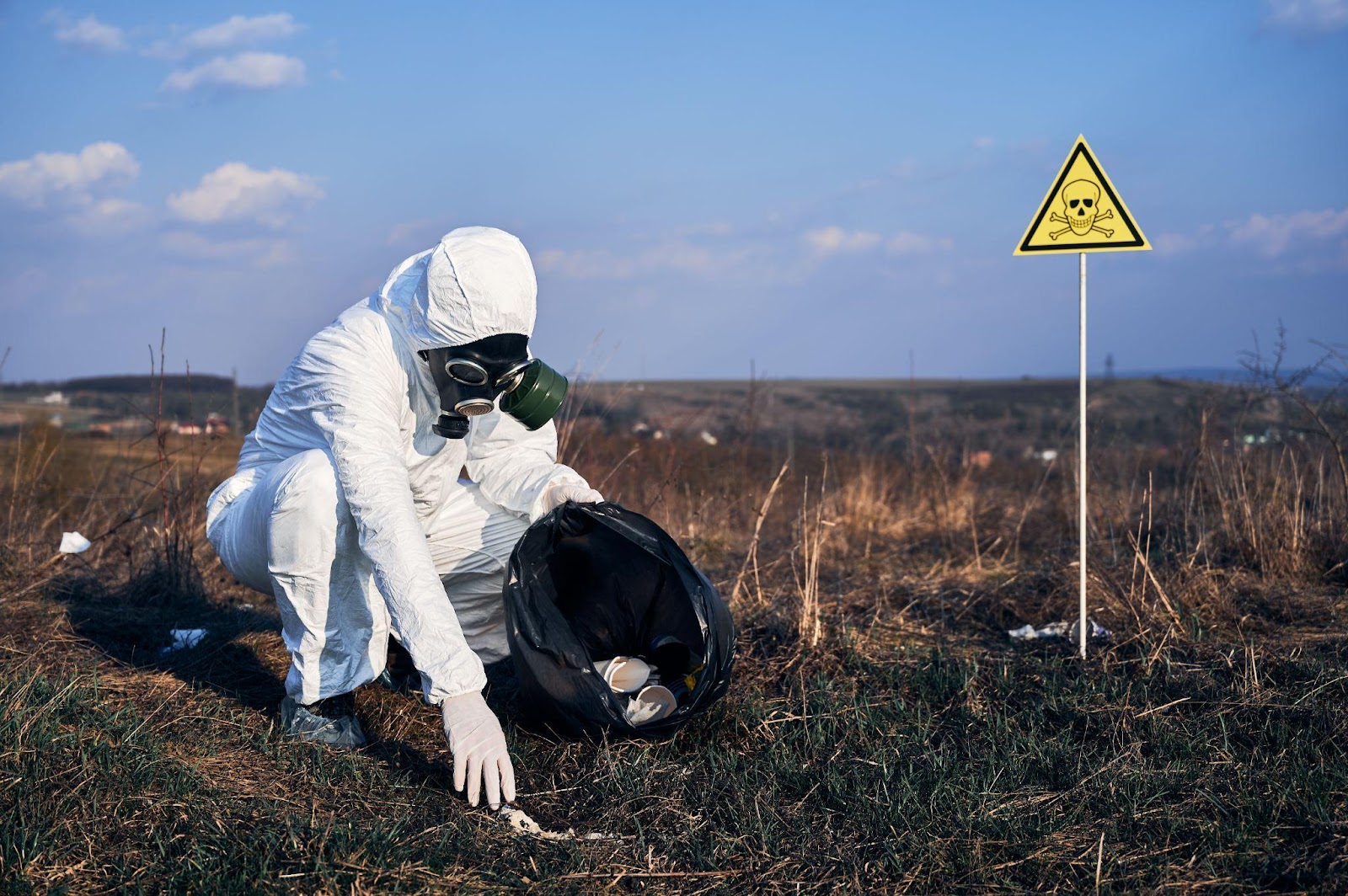
Environmental hazards and toxic exposure can have devastating effects on individuals, families, and communities.
In Alabama, residents face various potential risks, from industrial pollution to contaminated water sources.
Here, our Alabama attorneys will help you understand environmental hazards and toxic exposure claims, your rights under Alabama law, and the steps you can take to protect yourself and your loved ones.
What Are Environmental Hazards and Toxic Exposure?
Environmental hazards refer to situations or conditions in the environment that pose a risk to human health, safety, or well-being.
Toxic exposure occurs when individuals come into contact with harmful substances through various means, such as inhalation, ingestion, or skin contact.
These hazards can arise from natural sources or human activities, including:
- Industrial pollution;
- Water contamination;
- Air pollution;
- Soil contamination;
- Hazardous waste disposal;
- Pesticide use; and
- Radiation exposure.
Understanding the nature of environmental hazards and toxic exposure is crucial for identifying potential risks and taking appropriate action to protect yourself and your community.
Common Environmental Hazards in Alabama
Alabama faces several environmental challenges due to its industrial history and geographical features.
Some of the most common environmental hazards in the state include:
- Water Pollution: Contamination of rivers, lakes, and groundwater from industrial runoff, agricultural practices, and inadequate wastewater treatment.
- Air Quality Issues: Emissions from power plants, manufacturing facilities, and vehicle exhaust contribute to poor air quality in some areas.
- Soil Contamination: Industrial sites, landfills, and agricultural practices can lead to soil contamination with heavy metals, pesticides, and other toxins.
- Coal Ash Ponds: Alabama has numerous coal ash storage sites, which can pose risks of groundwater contamination and air pollution.
- Chemical Plant Emissions: Several chemical manufacturing facilities in the state may release potentially harmful substances into the environment.
- Asbestos Exposure: Older buildings and industrial sites may contain asbestos, posing a risk to workers and residents during renovations or demolitions.
- Lead Contamination: Aging infrastructure and old paint in homes can lead to lead exposure, particularly in children.
- Superfund Sites: Alabama has multiple Superfund sites, which are areas contaminated with hazardous substances requiring long-term cleanup efforts.
Awareness of these potential hazards can help you take necessary precautions and recognize when you may have been exposed to harmful substances.
Health Effects of Toxic Exposure
Exposure to environmental hazards and toxic substances can lead to a wide range of health issues, varying in severity and onset. Some effects may be immediate, while others may take years to develop.
Common health effects include:
- Respiratory problems (asthma, bronchitis, lung cancer);
- Skin irritations and diseases;
- Neurological disorders;
- Reproductive issues and birth defects;
- Cardiovascular diseases;
- Kidney and liver damage;
- Various types of cancer;
- Developmental delays in children;
- Immune system dysfunction; and
- Hormonal imbalances.
The specific health effects depend on factors such as the type of toxin, duration of exposure, concentration of the substance, and individual susceptibility.
If you suspect toxic exposure, it’s crucial to seek medical attention and document your symptoms and potential exposure sources.
Legal Framework for Environmental Claims in Alabama
Alabama’s legal system provides several avenues for individuals and communities to seek justice in cases of environmental hazards and toxic exposure.
Key aspects of the legal framework include:
- State Environmental Laws: Alabama has various state-specific environmental regulations, including the Alabama Environmental Management Act and the Alabama Water Pollution Control Act.
- Federal Environmental Laws: Federal statutes such as the Clean Air Act, Clean Water Act, and Comprehensive Environmental Response, Compensation, and Liability Act (CERCLA) also apply in Alabama.
- Common Law Claims: Individuals may pursue claims based on common law principles such as negligence, trespass, nuisance, and strict liability.
- Toxic Torts: These are civil lawsuits brought by individuals who have suffered harm due to exposure to hazardous substances.
- Environmental Justice Initiatives: Alabama recognizes the importance of addressing disproportionate environmental impacts on marginalized communities.
Understanding this legal framework is essential for navigating the complex landscape of environmental hazards and toxic exposure claims in Alabama.
Filing an Environmental Hazard or Toxic Exposure Claim
If you believe you have been harmed by an environmental hazard or toxic exposure, consider taking the following steps:
- Seek Medical Attention: Prioritize your health and obtain a thorough medical evaluation. This will also create documentation of your condition.
- Document Everything: Keep detailed records of your symptoms, medical treatments, and any evidence of exposure (e.g., photos, water samples).
- Report the Hazard: Notify relevant authorities, such as the Alabama Department of Environmental Management or the local health department.
- Consult an Attorney: Speak with a lawyer experienced in environmental and toxic tort cases to understand your legal options.
- Gather Evidence: Collect any available evidence of the hazard or exposure, including witness statements and official reports.
- Determine Liable Parties: Identify potential defendants, which may include property owners, manufacturers, or government entities.
- File a Claim or Lawsuit: Your attorney can help you file the appropriate legal action within the required timeframe.
- Participate in the Legal Process: Cooperate with your attorney throughout the discovery phase, negotiations, and potential trial.
Remember that each case is unique, and the specific steps may vary depending on your situation.
Compensation in Environmental and Toxic Exposure Cases
Victims of environmental hazards and toxic exposure may be eligible for various types of compensation, depending on the circumstances of their case.
Potential forms of compensation include:
- Medical expenses (past and future);
- Lost wages and diminished earning capacity;
- Pain and suffering;
- Property damage or loss of property value;
- Cost of environmental remediation; and
- Punitive damages (in cases of egregious misconduct).
The amount and type of compensation available will depend on factors such as the severity of harm, the strength of evidence, and the financial resources of the responsible parties.
Statute of Limitations for Environmental Claims
In Alabama, the statute of limitations for most personal injury claims, including those related to environmental hazards and toxic exposure, is generally two years from the date of injury or discovery of the injury.
However, there are exceptions and nuances to this rule:
- For property damage claims, the statute of limitations is six years.
- The “discovery rule” may apply in cases where the harm was not immediately apparent, potentially extending the time limit.
- Claims against government entities may have shorter notice requirements.
- Certain federal environmental laws may have different statutes of limitations.
Given these complexities, it’s crucial to consult with an attorney as soon as possible to ensure you don’t lose your right to pursue a claim.
Frequently Asked Questions
To help you better understand environmental hazards and toxic exposure claims in Alabama, we’ve compiled answers to some of the most common questions we receive.
How Do I Know If I’ve Been Exposed to a Toxic Substance?
Signs of toxic exposure can include unusual health symptoms, environmental changes (e.g., strange odors, discolored water), or official notifications. If you suspect exposure, consult a healthcare provider and consider environmental testing.
Can I File a Claim If I Was Exposed to a Hazardous Substance Years Ago?
Possibly. While there are statutes of limitations, some long-term health effects may not be immediately apparent. The “discovery rule” may allow you to file a claim based on when you discovered or reasonably should have discovered the harm.
What If Multiple Parties Are Responsible for the Environmental Hazard?
In cases with multiple responsible parties, you may be able to file claims against all of them. Alabama follows the rule of joint and several liability, meaning each defendant may be held responsible for the entire amount of damages.
How Long Do Environmental Hazard and Toxic Exposure Cases Typically Take?
These cases can be complex and time-consuming, often taking several years to resolve. Factors affecting the timeline include the complexity of the case, the number of parties involved, and whether the case goes to trial.
What If I Can’t Afford an Attorney for My Environmental Claim?
Many attorneys who handle environmental and toxic tort cases work on a contingency fee basis, meaning they only get paid if you win your case. Some non-profit organizations also provide legal assistance for environmental justice issues.
Protecting Your Rights and Your Health
Have you or a loved one been affected by an environmental hazard or toxic exposure in Alabama? Don’t face this challenging situation alone.
The experienced attorneys at Baxley Maniscalco are here to help you navigate the complex legal landscape and fight for the justice and compensation you deserve.
Contact us today for a free, confidential consultation. Our dedicated team will listen to your story, evaluate your case, and provide expert guidance on your legal options.
Don’t let time run out on your claim – take the first step towards protecting your rights and holding responsible parties accountable.
Can't find what you're looking for? Search our site below.










